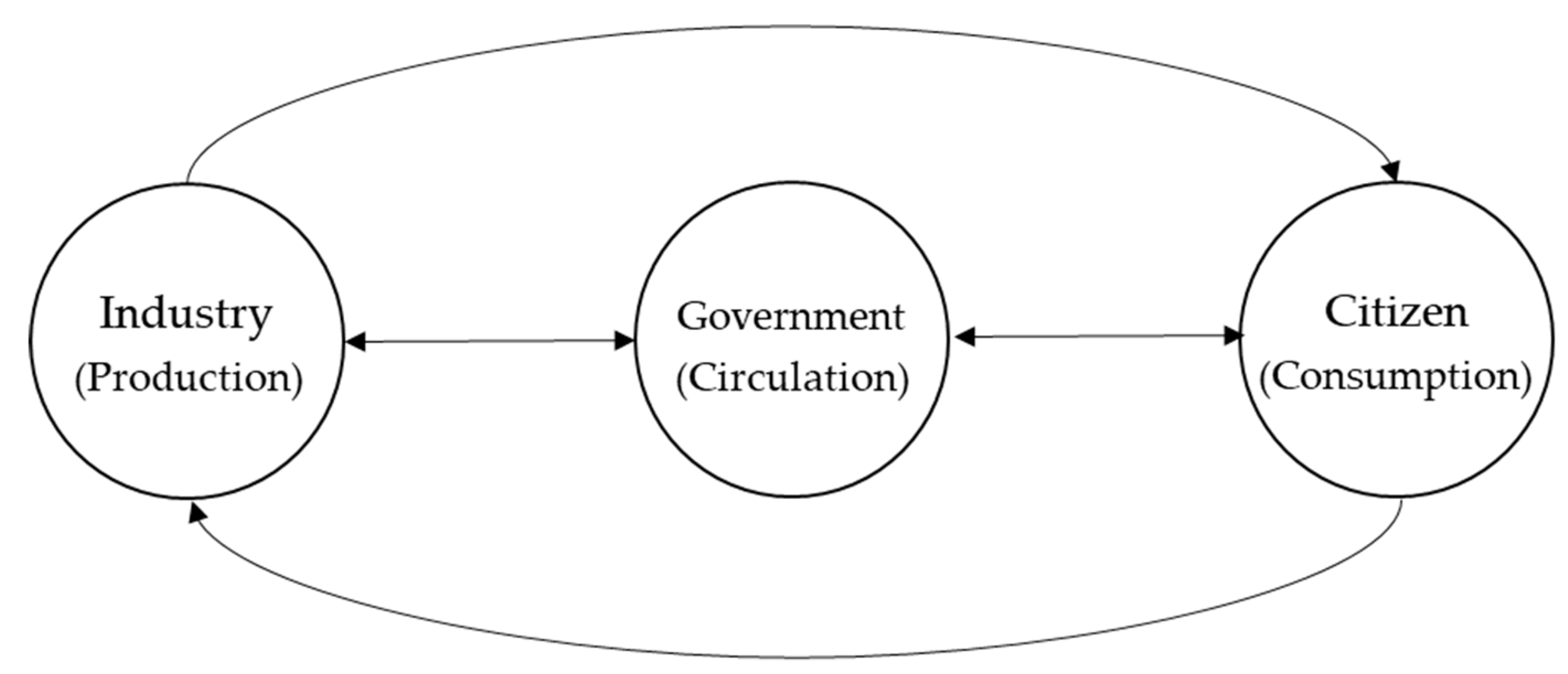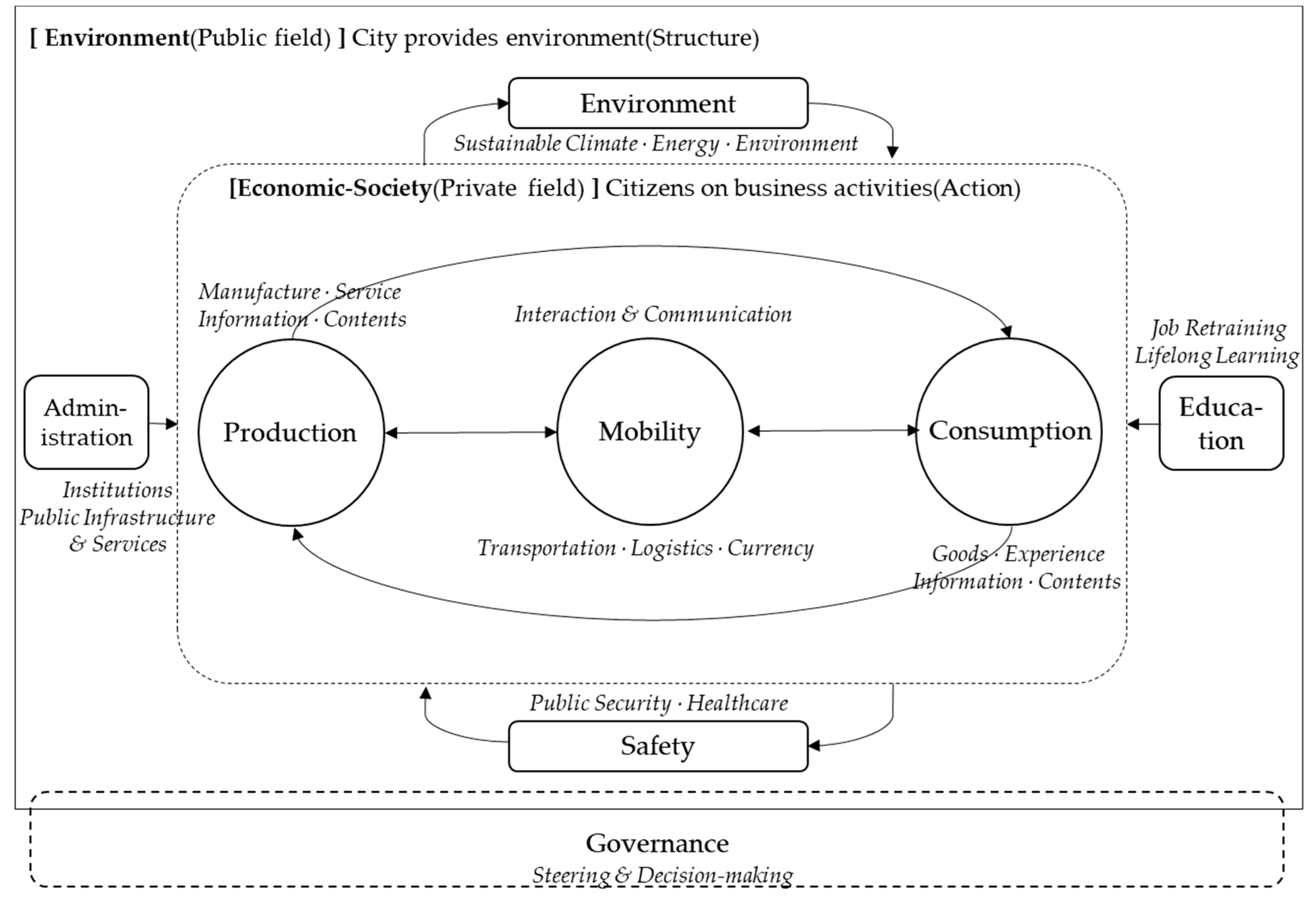Smart City 4.0 from the Perspective of Open Innovation
Abstract
:1. Introduction
2. Conceptual Research Model and Method
2.1. Research Question
2.2. Research Model and Method
3. Previous Research
3.1. Existing City Development Models
3.2. Previous Research on Development of a City
3.3. Smart City Policies in Major Countries
3.4. Relationship Between the City and the Complex System
4. Self-organizing Smart City 4.0 Model
4.1. Change in Relationship Between City Scale and Costs-Benefits with O2O Platform
4.2. Self-organizing Smart City 4.0 Model
4.3. Smart City 4.0 Implementation Technology-Social Model
4.4. Strategies to Build Smart Cities 4.0
5. Discussion of Results
6. Conclusions
Author Contributions
Funding
Acknowledgments
Conflicts of Interest
References
- UN. Revision of World Urbanization Prospects; UN: New York, NY, USA, 2018. [Google Scholar]
- Hwang, J. Smart City Development Outlook and Korea’s Competitiveness. In IT & Future Strategy; NIA: Seoul, Korea, 2016. [Google Scholar]
- Grech, G. Cities as Platforms; TechCrunch: San Francisco Bay Area, CA, USA, 2015. [Google Scholar]
- Barcelona City Council: Barcelona, Spain. Available online: metropolis.org/node/971 (accessed on 19 November 2019).
- Cohen, B. The 3 Generations of Smart Cities. 2015. Available online: https://www.fastcompany.com/3047795/the-3-generations-of-smart-cities (accessed on 19 November 2019).
- Eggers, D.; Skowron, J. Forces of change: Smart Cities. 2018. Available online: https://www2.deloitte.com/content/dam/insights/us/articles/4421_Forces-of-change-Smart-cities/DI_Forces-of-change-Smart-cities.pdf (accessed on 19 November 2019).
- Lee, M.; Ju, K.; Kim, A.; Kim, Y.; Yun, Y.; Jang, A.; Sohn, M.; Lee, M.; Cha, W.; Jung, H. A Policy Study for the Roadmap of the 4th Industrial Revolution; Special Committee on the 4th Industrial Revolution: Seoul, Korea, 2018. [Google Scholar]
- Alibaba Cloud webpage; Alibaba Cloud: Hangzhou, China, 2016; Available online: alibabacloud.com/et/city (accessed on 19 November 2019).
- West, G.B. Scale: The Universal Laws of Growth, Innovation, Sustainability, and the Pace of Life in Organisms, Cities, Economies, and Companies; Penguin Press: London, UK, 2017. [Google Scholar]
- Bouton, S.; Cis, D.; Mendonca, L.; Pohl, H.; Remes, J.; Ritchie, H.; Woetzel, J. How to Make a City Great; McKinsey & Compan: New York, NY, USA, 2013. [Google Scholar]
- Brooks, A.; Yesner, R.; Zannoni, M. IDC FutureScape: Worldwide Smart Cities 2018 Predictions; International Data Corporation: Framingham, MA, USA, 2017. [Google Scholar]
- Bughin, J.; Manyika, J.; Woetzel, J. Smart Cities: Digital Solutions for a More Livable Future; McKinsey Global Institute: New York, NY, USA, 2018. [Google Scholar]
- Nam, T.; Prado, T. Conceptualizing Smart City with Dimensions of Technology, People, and Institutions. In Proceedings of the the 12th Annual International Conference on Digital Government Research, College Park, MD, USA, 12–15 June 2011. [Google Scholar]
- Yigitcanlar, T.; Kamruzzanan, M.; Foth, M.; Marques, J.S.; da Costa, E.; Ioppolo, G. Can cities become smart without being sustainable? A systematic review of the literature. Sustain. Cities Soc. 2019, 45, 348–865. [Google Scholar] [CrossRef]
- Yigitcanlar, T.; Kamruzzaman, M.; Buys, L.; Ioppolo, G.; Sabatini-Marques, J.; Moreira, E.C.; Yun, J.J. Understanding ‘smart cities’: Intertwining development drivers with desired outcomes in a multidimensional framework. Cities 2018, 8, 145–160. [Google Scholar] [CrossRef]
- Hollands, R. Will the real smart city stand up: Creative, progressive, or just entrepreneurial? City 2008, 12, 302–320. [Google Scholar] [CrossRef]
- Florida, R. Cities and the Creative Class; Routledge: Abingdon-on-Thames, UK, 2008. [Google Scholar]
- Florida, R. In the Rise of the Creative Class; Basic Books: New York, NY, USA, 2002. [Google Scholar]
- Glaeser, E. Triumph of the City; Penguin Books: London, UK, 2001. [Google Scholar]
- Yun, J.J.; Jeong, E.; Yang, J. Open innovation of knowledge cities. J. Open Innov. Technol. Mark. Complex. 2015, 4, 11. [Google Scholar] [CrossRef]
- Gamboa, C.; Francisco, J. Knowledge-Based development as a new economic culture. J. Open Innov. Technol. Mark. Complex. 2015, 1, 1–17. [Google Scholar]
- Gamboa, C.; Francisco, J.; Yigitcanlar, T.; Velibeyoglu, K.; Martinez-Fernandez, C. Rising knowledge cities: The role of urban knowledge precincts. J. Knowl. Manag. 2008, 12, 8–20. [Google Scholar]
- Yun, J.J.; Zhao, X.; Yigitcanlar, T.; Lee, D.; Ahn, H. Architectural Design and Open Innovation Symbiosis: Insights from Research Campuses, Manufacturing Systems, and Innovation Districts. J. Sustain. 2018, 10, 4495. [Google Scholar] [CrossRef]
- Changizi, M.A.; Destefano, M. Common Scaling Laws for City Highway Systems and the Mammalian Neocortex. Complexity 2010, 15, 11–18. [Google Scholar] [CrossRef]
- Wedeen, V.J. The Geometric Structure of the Brain Fiber Pathways. Science 2012, 335, 1628–1634. [Google Scholar] [CrossRef] [PubMed]
- Hall, P. Cities of Tomorrow: An Intellectual History of Urban Planning and Design in the Twentieth Century; Basil Blackwell: Oxford, UK, 1988. [Google Scholar]
- Batty, M. Progress, success, and failure in urban modelling. Environ. Plan. 1979, 11, 863–878. [Google Scholar] [CrossRef]
- Lee, M.; Jang, A.; Park, G.; Han, S. The Complex System and the Transformation of the Network Society. Res. Broadcasting Commun. Paradig. Korean Soc. 2008, 8, 22. [Google Scholar]
- Henderson, J.V. The Sizes and Types of Cities. Am. Econ. Rev. 1974, 64, 640–656. [Google Scholar]
- Arnott, R. Optimal City Size in a Spatial Economy. J. Urban Econ. 1979, 6, 65–89. [Google Scholar] [CrossRef]
- Lichfield, N. Cost Benefits Analysis in Urban Expansion. J. Reg. Stud. 1969, 3, 123–155. [Google Scholar] [CrossRef]
- Gabris, G.; Reed, B.J. Responses of Cities to Federal Aid Decentralization. South. Rev. Public Adm. 1978, 2, 301–324. [Google Scholar]
- Gorden, P.; Richardson, H.W. Are Compact Cities a Desirable Planning Goal? J. Am. Plan. Assoc. 1997, 63, 95–106. [Google Scholar] [CrossRef]
- Reed, D.P. The Law of the Pack. Harv. Bus. Rev. 2001, 2, 23. [Google Scholar]
- KCERN. The 4th Industrial Revolution and the Smart City 4.0; KCERN: Seoul, Korea, 2018. [Google Scholar]
- London Data Store. Available online: https://data.london.gov.uk/ (accessed on 10 November 2019).
- Lee, M.; Kim, A. Technology model of the Fourth Industrial Revolution, AI+12 Tech. J. Korean Inst. Commun. Inf. Sci. 2017, 34, 3–8. [Google Scholar]
- Lee, M. 4th Industrial Revolution of Korea; KCERN: Seoul, Korea, 2017. [Google Scholar]
- Lee, M.; Yun, J.; Pyka, A.; Won, D.; Kodama, F.; Schiuma, G.; Park, H.; Jeon, J.; Park, K.; Jung, K.; et al. How to Respond to the Fourth Industrial Revolution, or the Second Information Technology Revolution? Dynamic New Combinations between Technology, Market, and Society through Open Innovation. J. Open Innov. Technol. Mark. Complex. 2018, 4, 12. [Google Scholar] [CrossRef]
- Cooke, P.; Yun, J.; Zhao, X.; Kim, Y. The digital, quaternary or 4.0 web economy: aspects, effects and implications. Int. J. Knowl. Based Dev. 2019, 10, 193–212. [Google Scholar] [CrossRef]






| Area | Smart City Policy | Characteristics | |
|---|---|---|---|
| Europe | [Europe 2020 (2010)] A strategy for smart, sustainable and inclusive growth | Centered Public-Private cooperation Environment, Mobility Open data to connect | |
| [Launching EIP-SCC (2011)] European Innovation Partnership for Smart Cities & Communities focus on Energy, Transport, and ICT | |||
| [Smart City Conference (2013)] “Strategic Implementation Plan” of the Smart Cities and communities Partnership (mobility, environment, infrastructure) | |||
| [Horizon 2020 (2014)] Financial instruments for cities for urban development (minimum of EUR 16 billion over the period 2014–2020) | |||
| [The WiFi4EU initiative (2018)] provides municipalities with the opportunity to apply for vouchers to the value EUR 15.000 (WWW.WIFI4EU.EU) | |||
| USA | [Strategy for American Innovation (2009)] Innovation for sustainable growth and quality jobs | Privat-led Mobility, Energy High value-added industry | |
| [The Smart America Challenge (2013)] Using IoT Platform to improve from quality of the air and water to transportation, energy, and communication system (smartamerica.org) | |||
| [Smart City Initiative (2015)] investment over $160 million in federal research and leverage more than 25 new technology collaborations | |||
| [Smart City Challenge (2017)] Smart transportation system that would use data, applications, and technology to help people and goods move supported by US Department of Transportation | |||
| Asia | China | The Ministry of Housing and Urban-Rural Development announced the first list of national pilot Smart Cities (2013) and promoted about 500 Smart City pilots from 2014. | Government-led City competitiveness Economic revitalization |
| Korea | [Ubiquitous-City (2009)] solving city problems using ICT technologies [Smart City initiative (2015)] investment to establish and spread Smart City integrated platform and construct 2 Smart Cities (Busan, Sejong) as a pilot project (2018) | ||
| Japan | [New Growth Strategy (2010)] Government identified the ‘FutureCity initiative’ as one of the national strategic projects [Future Investment Strategy (2016)] ‘Society 5.0’ was suggested for future Smart City blueprint(healthcare, mobility, supply chain, city infrastructure, fintech) | ||
| India | [Smart Cities Mission (2014, 2015)] Government declared achievement of 100 Smart Cities across the country | ||
| Singapore | [Infocomm Media 2025 (2015)] Establishing a smart nation platform for sustainable and quality growth and better quality of life using digital twin technologies (Virtual Singapore) | ||
| Smart City 1.0 | Smart City 2.0 | Smart City 3.0 | |
|---|---|---|---|
| Connectivity | Until emergence of PC | Wired Internet | Wireless internet, IoT, etc |
| Human | Five senses | Neural network | Brain |
| City | Sensors | Sensors + Communication | Sensors + Communication + AI |
| Example | Barcelona Digital city(earlier version) | Korea U-city | Singapore Digital Twin city Hangzhou intelligent city |
| City size (Cost/Benefit) | Limited (Optimization) | Expansion | Giantization |
| Value | Sarnoff’s Law N | Metcalfe’s Law | Reed’s Law |
| Smart City 1.0 | Smart City 2.0 | Smart City 3.0 | Smart City 4.0 | |
|---|---|---|---|---|
| Connectivity | Until emergence of PC | Wired Internet | Wireless internet, IoT | Cloud + Edge Blockchain |
| Human | Five senses | Neural network | Brain | Behavior (Life) |
| City | Sensors | Sensors + Communication | Sensors + Communication + AI | Sensors + Communication + AI + Citizen |
| City size (Cost/Benefit) | Limited (Optimization) | Expansion | Giantization | Self-organizing |
| Value | Sarnoff’s Law N | Metcalfe’s Law | Reed’s Law | |
© 2019 by the authors. Licensee MDPI, Basel, Switzerland. This article is an open access article distributed under the terms and conditions of the Creative Commons Attribution (CC BY) license (http://creativecommons.org/licenses/by/4.0/).
Share and Cite
Yun, Y.; Lee, M. Smart City 4.0 from the Perspective of Open Innovation. J. Open Innov. Technol. Mark. Complex. 2019, 5, 92. https://doi.org/10.3390/joitmc5040092
Yun Y, Lee M. Smart City 4.0 from the Perspective of Open Innovation. Journal of Open Innovation: Technology, Market, and Complexity. 2019; 5(4):92. https://doi.org/10.3390/joitmc5040092
Chicago/Turabian StyleYun, Yeji, and Minhwa Lee. 2019. "Smart City 4.0 from the Perspective of Open Innovation" Journal of Open Innovation: Technology, Market, and Complexity 5, no. 4: 92. https://doi.org/10.3390/joitmc5040092
APA StyleYun, Y., & Lee, M. (2019). Smart City 4.0 from the Perspective of Open Innovation. Journal of Open Innovation: Technology, Market, and Complexity, 5(4), 92. https://doi.org/10.3390/joitmc5040092






